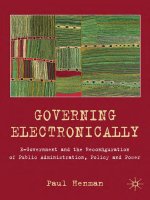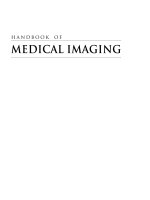THE HANDBOOK OF NANOTECHNOLOGY Business, Policy, and Intellectual Property Law pdf
Bạn đang xem bản rút gọn của tài liệu. Xem và tải ngay bản đầy đủ của tài liệu tại đây (2.93 MB, 383 trang )
TeAM
YYePG
Digitally signed by TeAM YYePG
DN: cn=TeAM YYePG, c=US,
o=TeAM YYePG, ou=TeAM
YYePG, email=
Reason: I attest to the accuracy
and integrity of this document
Date: 2005.06.22 14:53:22
+08'00'
More Praise for The Handbook of Nanotechnology
“As someone who has successfully transitioned nanotechnology
from the university lab to the commercial world, I can recommend
this book as a ‘must-read’ for nascent academic entrepreneurs,
those wishing to commercialize technologies they have developed
at the university. As a faculty member at a major research univer-
sity that is comprehensively involved in nanoscience and nano-
technology research, I come into continual contact with such
persons: I can now point them to the first book they should study.
The chapters on business development are particularly valuable;
I wish I had had this book 5 years ago.”
—Max G. Lagally, founder nPoint,
and professor of Surface Science,
at the University of Wisconsin-Madison
“In order for our society to realize the awe-inspiring potential for
revolutionary change which nanotechnology promises in every
industry from transportation to pharmaceuticals, complex issues
of business, public policy and law must be managed at the highest
levels of leadership in both the public and private sector. This
Handbook provides an invaluable guide for that leadership.”
—Rodney E. Slater,
former U.S. Secretary of Transportation
and partner at the law firm of Patton Boggs
ffirs_miller.qxd 8/12/04 5:22 PM Page i
“This is an excellent work that is both comprehensive and prac-
tical across a wide range of perspectives. It is great to have solid,
detailed analysis of and advice on the science, business, and policy
aspects of nanotechnology. This is one of the few publications to
identify both the commonality of nanotechnology with existing
industry and regulatory structures as well as its unique character-
istics that have implications for policy, law, and running a busi-
ness. It is a book that intelligently anticipates future developments
in policy and intellectual property, as well as mergers and other
financing activity.”
—Randy Levine, Ph.D.,
president and CEO, ZettaCore, Inc.
“Indispensable. I can’t imagine an attorney or policy maker not
having this book on their shelf. It is an extraordinarily insightful
and thorough book that delves into the intricacies of the emerg-
ing nanotechnology field in an accessible and easy-to-understand
manner.”
—F. Mark Modzelewski,
founder of the NanoBusiness Alliance
and managing director, Lux Research, Inc.
ffirs_miller.qxd 8/12/04 5:23 PM Page ii
THE HANDBOOK OF
NANOTECHNOLOGY
Business, Policy, and
Intellectual Property Law
John C. Miller
Arrowhead Research Corporation
Ruben M. Serrato
Canon U.S.A.
Jose Miguel Represas-Cardenas
Stanford University
Griffith A. Kundahl
NanoBusiness Alliance
with an editorial contribution by
Mark Graffagnini
John Wiley & Sons, Inc.
ffirs_miller.qxd 8/12/04 5:23PM Pageiii
Copyright © 2005 by John C. Miller, Ruben Serrato, Jose Miguel Represas-
Cardenas, and Griffith Kundahl. All rights reserved.
Published by John Wiley & Sons, Inc., Hoboken, New Jersey.
Published simultaneously in Canada.
No part of this publication may be reproduced, stored in a retrieval system, or
transmitted in any form or by any means, electronic, mechanical, photocopying,
recording, scanning, or otherwise, except as permitted under Section 107 or 108 of
the 1976 United States Copyright Act, without either the prior written permission
of the Publisher, or authorization through payment of the appropriate per-copy fee
to the Copyright Clearance Center, Inc., 222 Rosewood Drive, Danvers, MA 01923,
978-750-8400, fax 978-646-8600, or on the web at www.copyright.com. Requests
to the Publisher for permission should be addressed to the Permissions Department,
John Wiley & Sons, Inc., 111 River Street, Hoboken, NJ 07030, 201-748-6011,
fax 201-748-6008.
Limit of Liability/Disclaimer of Warranty: While the publisher and author have used
their best efforts in preparing this book, they make no representations or warranties
with respect to the accuracy or completeness of the contents of this book and specifi-
cally disclaim any implied warranties of merchantability or fitness for a particular
purpose. No warranty may be created or extended by sales representatives or written
sales materials. The advice and strategies contained herein may not be suitable for
your situation. You should consult with a professional where appropriate. Neither the
publisher nor author shall be liable for any loss of profit or any other commercial dam-
ages, including but not limited to special, incidental, consequential, or other damages.
For general information on our other products and services, or technical support,
please contact our Customer Care Department within the United States at
800-762-2974, outside the United States at 317-572-3993 or fax 317-572-4002.
Wiley also publishes its books in a variety of electronic formats. Some content that
appears in print may not be available in electronic books.
For more information about Wiley products, visit our web site at www.wiley.com.
Library of Congress Cataloging-in-Publication Data
The handbook of nanotechnology business, policy, & intellectual property
law : preparing industry and policy makers for the revolution in
nanotechnology / John C. Miller [et al.].
p. cm.
Includes bibliographical references and index.
ISBN 0-471-66695-5
1. Microelectronics industrty. 2. Nanotechnology—Industrial
applications. 3. Intellectual property. I. Title: Handbook of
nanotechnology business, policy, and intellectual property law.
II. Miller, John C.
HD9696.A2H36 2004
620.5′068—dc22
2004009884
Printed in the United States of America
10987654321
ffirs_miller.qxd 8/12/04 5:23 PM Page iv
This book is dedicated to the Nomads, who take
risks to follow their dreams.
ffirs_miller.qxd 8/12/04 5:23 PM Page v
ffirs_miller.qxd 8/12/04 5:23 PM Page vi
Contents
Acknowledgments ix
Foreword xi
Introduction 1
Part I: Introduction to Nanotechnology 11
Chapter 1: Understanding Nanotechnology 13
Chapter 2: The Industrial Structure Giving Rise
to Nanotechnology 33
Part II: Nanotechnology Policy and Regulation 39
Chapter 3: Societal and Ethical Implications 41
Chapter 4: Environmental Regulation 51
Chapter 5: The Patent and Trademark Office 65
Chapter 6: FDA Regulation 83
Chapter 7: National Security and Export Controls 103
Chapter 8: Federal Funding 115
Chapter 9: Conclusions 131
Part III: Nanotechnology Business 137
Chapter 10: Starting a Nanotech Company 139
Chapter 11: Business Plans and Strategy 161
Chapter 12: Early Stage Financing 189
Chapter 13: Intellectual Property 209
Chapter 14: Corporate Partnering and Globalization 235
Chapter 15: Consolidation and Standardization 251
Chapter 16: Exit Opportunities 267
Chapter 17: Conclusions 281
Notes 287
About the Authors 355
Index 357
vii
ftoc_miller.qxd 8/12/04 5:25 PM Page vii
ftoc_miller.qxd 8/12/04 5:25 PM Page viii
Acknowledgments
Special thanks to all of our families and friends: Caroline Campbell, Mike,
Scotti, and Brian Miller, Wayne and Ila Harris, Bob Gilliland, Ruben, Rafaela,
Linda, and especially Gabriel Serrato, Jose Represas-Perez and Ana Beatriz
Cardenas, Chuck Ballingall, Bill Southworth, Byron Arthur, Kim, Kate, and
Caroline Kundahl, and Cheryl and Joseph Graffagnini.
John also wishes to thank the Campbell family for providing hospitality in
Australia and Palo Alto during the writing of this book and Professor Hank
Greely for providing inspiration to see the book to completion.
Jose Miguel also wishes to thank the Department of Electrical Engi-
neering at Stanford University for his fellowship award, as well as the many
professors that over the years have been examples of generosity, intellectual
independence, and scientific integrity.
We would also like to thank all of the people that provided ideas, com-
ments, and assistance:
Mark Modzelewski (NanoBusiness Alliance); K.J. Cho (Stanford
University); Mike McGehee (Stanford University); Hari Manoharan (Stan-
ford University); Leon Radomsky (Foley & Lardner); Ken Barovsky
(Quantum Dot Corp.); Steve Maebius (Foley & Lardner); Rita Colwell
(National Science Foundation); Larry Bock (Nanosys); Margaret Radin
(Stanford Law School); John Barton (Stanford Law School); Deborah Hensler
(Stanford Law School); Joe Grundfest (Stanford Law School); Rich Wolf
(Caltech Office of Technology Transfer); Max Lagally (nPoint); Katharine Ku
and Linda Chao (Stanford Office of Technology Licensing); Veronica Lanier
and Carol Mimura (Berkeley Office of Technology Licensing); Rebecca
Goodman and Robert Nidever (UCLA Technology Licensing Office); Joyce
Brinton and Robert Benson (Harvard Technology Licensing Office); Craig
Zolan (Uventures); Randy Levine (ZettaCore); Rodney Slater (Patton Boggs);
Randy Bell (Nanotechnologies Inc.); J. Kevin Gray (Fish & Richardson P.C.);
John Belk (The Boeing Corporation); Chad Mirkin (Northwestern Uni-
versity); Mark R. Wiesner (Rice University); Vicki Colvin (Rice University);
Jess Milbourn and Thomas Schults (PST); Christine Peterson (Foresight
Institute); Nadrian Seeman (NYU); Joe Mauderly (Lovelace Respiratory
Research Institute); Kathy Jo Wetter (ETC Group); Elisabeth Lutanie
(Institute of Physics); Terry Lowe (Metallicum); Robert Bradbury (Robo-
biotics); Bruce Stewart (Arrowhead Research Corporation); Peter Grubstein
(NGEN Partners); Raj Bawa (Bawa Biotechnology Consulting and Rensselaer
ix
flast_miller.qxd 8/17/04 1:24 PM Page ix
Polytechnic Institute); Donald Marlow (FDA); Jim Hurd (Nanoscience Ex-
change); Chad Wieland and Nhat D. Phan (Burns, Doane, Swecker & Mathis,
L.L.P.); Jeffrey Weinshenker (FDA); Eric Werwa (Rep. Honda’s Office); Ben
Boyer (Lehman Brothers); Doug Jamison (Harris & Harris Group, Inc.); Phil
Sayre (EPA); Bill Goddard (Caltech); Edward Rashba (IEEE); and Daniel
Gamota (Motorola).
Finally, special thanks to Dr. Barbara Karn (EPA) for facilitating the peer
review process with federal agencies and Dr. David Reisner (Inframat) for his
extensive, detailed review and comments.
xACKNOWLEDGMENTS
flast_miller.qxd 8/17/04 1:24 PM Page x
Foreword
On January 21, 2000, President Clinton unveiled the National Nano-
technology Initiative (NNI) in a major policy address at Caltech. In his
speech, he announced that his budget would propose almost doubling the
federal investment in nanoscale science and engineering, from $270 million
in FY2000 to $495 million in FY2001. He asked his audience to imagine
“materials with 10 times the strength of steel and only a fraction of the
weight; shrinking all the information at the Library of Congress into a device
the size of a sugar cube; detecting cancerous tumors that are only a few cells
in size.” The next week, with 51 million Americans watching, Clinton again
referred to the promise of nanotechnology in his State of the Union address.
(His speech writers tried to take this section out to shorten the 89-minute
speech, but Clinton insisted on leaving it in!)
As a strong supporter of the NNI, I was thrilled that President Clinton
had decided to embrace it as one of his top science and technology priorities.
I had the privilege of working for President Clinton and Vice President Gore
for eight years, and eventually served as the Deputy Director of the White
House National Economic Council and the Deputy Assistant to the President
for Technology and Economic Policy.
I was convinced that there is a strong intellectual case for increasing the
federal government’s investment in nanoscale science and engineering. First,
nanotechnology has the potential to be what economists call a “general pur-
pose” technology—similar in the size and scope of its economic and socie-
tal impact to the steam engine, electricity, the transistor, and the Internet.
Second, long-term, high-risk research will be needed to realize the potential
of nanotechnology. Some of this research is beyond the time horizons of indi-
vidual firms, and government support for research is critical when firms can-
not fully capture the benefits of investing in research and development.
Third, the NNI can help address the growing imbalance between biomedical
research and the physical sciences and engineering by increasing support for
critical disciplines such as condensed matter physics, chemistry, materials
science, and electrical engineering. Fourth, the NNI will help create the
workforce of the twenty-first century, since most of the government funds
support university research. Furthermore, as Nobel Laureate Rick Smalley
has observed, nanotechnology might get our young boys and girls excited
about science and engineering, in the same way that Sputnik or the space race
captured the public’s imagination in previous generations. Finally, global
xi
flast_miller.qxd 8/17/04 1:24 PM Page xi
leadership in nanotechnology is up for grabs, and increased federal invest-
ment will help strengthen the U.S. position in this key area.
The development of the NNI began in earnest in September 1998, when
the White House created a working group on Nanoscience, Engineering,
and Technology under the auspices of the National Science and Technology
Council (NSTC). I served as the White House Co-Chair, and Mike Roco,
the point person on nanotechnology for the the National Science Foundation
(NSF), served as the Chair. In January 1999, the NSTC convened a work-
shop with experts from industry and academia. University researchers such as
UC Berkeley’s Paul Alivisatos and industrial researchers such as Hewlett-
Packard’s Stan Williams helped identify the most important and promising
R&D opportunities in nanoscale science and engineering.
Throughout 1999, dedicated public servants like Mike Roco (NSF), Jim
Murday (Naval Research Laboratory), Iran Thomas (Energy), Meyya
Meyyapan (NASA), Jeff Schloss from the National Institutes of Health (NIH),
and Kelly Kirkpatrick from the Office of Science and Technology Policy
(OSTP), worked tirelessly to develop a concrete proposal for the President’s
FY2001 budget. My colleagues at the OSTP and I met with senior officials
from the science agencies; we convinced them that we would fight to protect
any increases in nanotechnology research that they proposed as part of their
budget submission to the Office of Management and Budget. We also asked
the President’s Council of Advisors on Science and Technology to review our
proposal, which they strongly endorsed.
I also began to ask federal program managers and leading researchers in
the field to identify potential “grand challenges”—ambitious but plausible
outcomes from increased research in nanoscale science and engineering.
Although I knew that it was impossible to predict what might eventually
come out of the NNI, my time in the White House had taught me that it was
essential to identify some exciting possibilities that could be easily understood
by politicians, reporters, and the general public. Armed with these examples
(several of which wound up in Clinton’s Caltech speech and State of the
Union address), I started briefing the most senior White House staff about
nanotechnology—people like Gene Sperling, the head of the National
Economic Council, John Podesta, the President’s Chief of Staff, and David
Beier, Vice President Gore’s Chief Domestic Policy Adviser.
In the fall of 1999, the White House staff began to identify possible initia-
tives for consideration by President Clinton. I convinced Gene Sperling that
nanotechnology should be one of the priorities in the President’s FY2001
budget, as part of a larger increase in support for science and technology that
we called the “21st Century Research Fund.” Neal Lane, the President’s
Science Advisor, was also a staunch advocate for the NNI. Working together,
the National Economic Council and the Office of Science and Technology
Policy made a compelling case to President Clinton to support a large increase
xii FOREWORD
flast_miller.qxd 8/17/04 1:24 PM Page xii
for the NNI in his budget. In a December 1999 meeting in the White House
Cabinet Room, President Clinton approved the NNI.
Although hardly an impartial observer, I believe that President Clinton’s
decision to launch the NNI served as a catalyst for increased investment by
universities, large companies, venture capitalists, and state governments.
Federal expenditures have continued to rise during the Bush administration,
and will reach nearly $1 billion in the FY2005 budget. Media coverage of
nanoscience and nanotechnology has exploded, and Congress has passed leg-
islation that authorizes the NNI for four years. Many foreign governments
have also increased their investments in nanotechnology research.
Of course, only time will tell whether these increased public and private
investments in nanotechnology will lead to revolutionary advancements in
computing and communications, clean energy, health care, transportation,
advanced materials, environmental applications, national security, and space
exploration. As President Clinton noted in his Caltech speech, “some of these
research goals will take 20 or more years to achieve.” There is always the risk
that advocates of nanotechnology, whether in government, industry, finance,
or academia, will overpromise and underdeliver.
What is clear is that we must now address the ethical, legal, policy, regu-
latory, and business issues associated with the commercialization of nanotech-
nologies. This is why The Handbook of Nanotechnology is so timely. John Miller,
Ruben Serrato, Jose Miguel Represas-Cardenas, and Griffith Kundahl have
done a terrific job of analyzing the key economic and societal issues facing
nanotechnology. How should the EPA regulate nanomaterials, which may
have different environmental and human health effects than the same mate-
rials in bulk? Will the Patent and Trademark Office be able to handle the
rush to file nanotechnology patents without slowing down the rate of inno-
vation? How can the government most effectively manage its investment in
nanoscale science and engineering? How can entrepreneurs successfully
launch nanotechnology start-ups? The Handbook of Nanotechnology is invalu-
able for anyone who is seeking to move nanotechnology from the lab to the
marketplace in an ethical and responsible fashion.
—T
HOMAS A. KALIL
July 2004
FOREWORD xiii
flast_miller.qxd 8/17/04 1:24 PM Page xiii
flast_miller.qxd 8/17/04 1:24 PM Page xiv
Introduction
Congress, Washington D.C.: 2000
Congress is a long way from the Texas laboratory where Richard Smalley
made his Nobel Prize–winning discovery. Nevertheless, the gray-bearded sci-
entist speaks with more than just confidence—he has a fiery passion. Perhaps
he is inspired by an ardent desire to cure a vicious disease; perhaps he wants
to express to the world the importance of his life’s work. Dr. Smalley declares:
But twenty years from now, nanotechnology will have given us specially
engineered drugs . . . Cancer—at least the type that I have—will be a
thing of the past.
1
The politicians are persuaded.
Silicon Valley, CA: 2003
The investors take their seats in the polished conference room on Sand Hill
Road. Although still visibly weathered by the dot-com storms, they are some-
what upbeat. The sky is clear, and there is something new in the air. Veteran
entrepreneur Larry Bock dims the lights and starts the tape. The screen lights
up, and it is Mr. Robinson from the film The Graduate. “Benjamin, can I have
a word with you?” The tall, handsome college graduate nervously consents
and walks down the hall with Mr. Robinson. “Benjamin, I just want to say one
word are you listening?” “Yes sir,” replies the graduate. “Nanotechnol-
ogy ” says the older man. The investors are intrigued.
1
cintro_miller.qxd 8/12/04 5:21 PM Page 1
Pentagon, Washington D.C.: 2002
In one of the deepest, darkest rooms in the Pentagon, five-star generals and
White House officials meet. In light of recent international events, there is a
great deal of unease—it seems the future has never been more uncertain. But
today the generals are confident as they present their vision of the military
battle suit of the twenty-first century, a suit enhanced by nanotechnology. It
can change color to blend in with the surrounding environment and can
transform itself from a soft fabric into bulletproof armor. Sensors in the suit
detect when the soldier is wounded, tiny devices transmit vital signals to a dis-
tant medic, and antidotes are released. It even enables a soldier to jump
twenty feet in the air. The presentation ends and the president is encouraged.
IBM Headquarters, Armonk, NY: 2002
When IBM’s CEO Louis Gerstner hears from Phaedon Avouris, he knows
it is time to listen. Avouris, head of IBM’s nanoscience and technology group,
is a skeptical scientist. Reporters turn to him for a “realistic assessment” of
semiconductor technology. Today Gerstner is intrigued by Avouris’ unusual
excitement. Avouris hands the CEO an image of what appear to be thin
threads laid out in a crisscross fashion. On closer examination, Gerstner iden-
tifies the microscopic image as a logic gate—the fundamental computer com-
ponent responsible for selectively routing electrical signals and transforming
them into meaningful ones and zeros. Comprised of carbon nanotubes, this
transistor is one of the first examples of molecular-scale electronics. Avouris
boldly remarks,
[I]t is no longer a question of whether nanotubes will become useful
components of the electronic machines of the future but merely a ques-
tion of how and when.
2
Gerstner is convinced.
While advances in biotechnology and the rise of the Internet dazzled
investors and made headlines in the final years of the twentieth century, a
quiet revolution was taking place in the field of nanotechnology. In 2000, the
National Science and Technology Council (NSTC) observed that nanotech-
nology, which involves the manipulation of matter at the atomic and molec-
ular levels, “could be at least as significant as the combined influences of
microelectronics, medical imaging, computer-aided engineering, and man-
made polymers” developed in the last century.
3
Nanotechnologies may speed
cures for cancer and AIDS, make possible solar and hydrogen fuel cells to
eliminate reliance on fossil fuels, or enable computers with magnificent pro-
cessing power. Dr. K. Eric Drexler, one of nanotechnology’s most controver-
sial figures, goes so far as to predict that nanotechnology will result in
2INTRODUCTION
cintro_miller.qxd 8/12/04 5:21 PM Page 2
self-replicating nanorobots capable of doing everything from assembling
automobiles to unleashing weapons of mass destruction.
As with any promising new technology, the difference between hyper-
bolized rhetoric and scientific reality may not be immediately apparent. It is
clear, however, that nanotechnology is already a significant factor in the
nation’s long-term strategy for continued scientific and industrial leadership.
At the federal level, government funding has grown dramatically since
President Clinton launched the $422 million National Nanotechnology
Initiative (NNI) in 2000. For fiscal year (FY) 2004, the Bush administration
doubled NNI funding to $847 million. In December 2003, Congress passed
the 21st Century Nanotechnology Research and Development Act, which
authorized $3.7 billion for nanoscale science and engineering projects between
FY 2005 and FY 2008. The goal of this program is to galvanize the field by
allocating funds for fundamental research, new science centers, a new national
research infrastructure, workforce education and training, and further study
of the ethical, legal, and societal implications of nanotechnology. At the state
level, legislatures have also begun to channel funds toward nanotechnology
and many such as California, Illinois, and Massachusetts have created task
forces to attract new nanotech companies and federal research dollars.
Government funding of nanotechnology is also being complemented by
private investment. Venture capitalists are actively focused on finding nano-
technology investments and have poured more than $1 billion in to new
companies over the last few years. Eager individual investors are attending
conferences, creating investment groups and buying nanotech investment
reports. Many of the world’s largest private companies are also very active
nanotech investors. Corporations like Hewlett-Packard, IBM, and Intel are
allocating substantial portions of their research budgets to nanotechnology.
Other large companies like Canon and the Boeing Corporation are making
direct investments in nanotech companies.
Outside of the United States, many countries now recognize that their
global trade competitiveness will soon be dictated by their competency in
nanoscale research and development. Japanese and European Community
government investments in nanotech currently rival U.S. expenditures. Their
leading universities such as Osaka University and Oxford University have
nanotech development programs modeled after the best universities in the
United States. China, South Korea, Canada, Taiwan, Russia, Germany, and
the Netherlands also have significant government programs designed to
attract and retain scientists. The international community is actively gearing
up for the day when nanotech leadership could be the most important factor
in determining global economic and political leadership.
Despite the rapid progress in nanoscale research and the massive invest-
ments taking place, little attention has been devoted to the legal, policy, reg-
ulatory, and business issues associated with this new era of technological
power. This book is the first attempt to fully explore these issues and prepare
Introduction 3
cintro_miller.qxd 8/12/04 5:21 PM Page 3
industry, government, and society for the revolution in nanotechnology. The
book is divided into three parts. Part I provides an overview of nanotechnol-
ogy, describes the industrial structure giving rise to its commercial develop-
ment, and identifies areas where nanotech is having the greatest impact. Part
II focuses on the regulatory and policy issues confronting those in the field.
It explores how federal agencies and Congress should prepare for nanotech-
nology. As such, it is directed to an audience of regulators, policymakers, and
industry leaders. Part III explores the legal and business issues confronting
nanotech companies and is directed to individual managers, lawyers,
investors, and scientists. In the following pages, we provide a brief overview
of the contents of each section.
PART I: INTRODUCTION TO NANOTECHNOLOGY
In order to walk through the legal, policy, regulatory, and business issues in
this field, it is necessary to first understand the scientific underpinnings and
potential applications of the technology. In Chapter 1, we provide a clear and
technical description of nanotechnology. Chapter 2 builds on this scientific
foundation by creating a model of the industrial structure giving rise to nano-
technology. It is our hope that these two chapters will enable readers to dis-
tinguish between likely applications in the near future and long-term visions
that may or may not be realized.
PART II: NANOTECHNOLOGY POLICY AND REGULATION
As of this writing, there has been no coordinated framework for regulation of
nanotechnology. In September 2000, the National Science and Technology
Council, Committee on Technology, Subcommittee on Nanoscale Science,
Engineering, and Technology (NSET)—the federal interagency group coor-
dinating the NNI—brought together the first group of nanotechnology
researchers, social scientists, and policymakers to address “how nanotechnol-
ogy will change society and the measures to be taken to prepare for these
transformations.”
4
Although the resulting work, Societal Implications of Nano-
science and Nanotechnology Report, was useful as a springboard for policy dis-
cussion, it did not provide an organized or prioritized analysis of the relevant
issues. Instead, the report was simply a collection of different people’s
thoughts on the societal impacts of nanotechnology. The report was not com-
prehensive, and many of the issues identified in this book were not even men-
tioned. Since the report took place in 2000, much of the discussion was also
necessarily an “inherently speculative exercise.”
5
The lack of well-informed and rigorous academic analysis of the policy
issues associated with nanotechnology is problematic. As we argue in the fol-
4INTRODUCTION
cintro_miller.qxd 8/12/04 5:21 PM Page 4
lowing chapters, the history of law and technology warns of the consequences
of the failure by policymakers and regulators to adequately prepare for rapid
technological progress. For example, misperceptions concerning the envi-
ronmental risks of nuclear power and agricultural biotechnology have pre-
cluded these domains from realizing their full potential. Patent decisions
made by courts and the Patent and Trademark Office have created substan-
tial barriers to progress in drug discovery and software, and mistakes made by
the Food and Drug Administration have plagued biotechnology for years.
But the greatest policy mistakes involve funding. In several instances, poor
preparation and insufficient communication with industry have resulted in
government funding of failed technologies.
Despite oxygen deprivation from political and regulatory mishaps, how-
ever, the flames of past emerging technologies have continued to burn. His-
tory may still write a different story about the ability of government to
adequately prepare for the advent of nanotechnology. Its far-reaching poten-
tial to radically transform the world renders it almost entirely dependent
upon government nurturing for its survival. Never before has the flame of a
technological movement relied as much on the oxygen supplied by govern-
ment officials as it does the wood provided by scientists. Unfortunately, while
the scientists are forging ahead, their counterparts in government are lagging
behind. Thus, a rigorous analysis of the legal, political, and regulatory issues
associated with nanotechnology is urgently needed.
Chapter 3
The first policy topic that we discuss is whether a “nano” world is desirable.
Bill Joy of Sun Microsystems launched the public debate about the wisdom
of pursuing nanotechnology research and development by highlighting the
field’s long-term threats. According to Joy, the convergence of nanotechnol-
ogy, robotics, and genetic engineering could produce “spiritual machines”
that ultimately replace humans. Further, accidental or intentional misuse of
self-replicating nanorobots could result in a catastrophe of cataclysmic pro-
portions. Thus far, the debate has been mostly limited to a shouting match
between doomsayers and scientists. Michael Crichton, author of Jurassic
Park, recently released a new thriller depicting nanorobots that invade and
take control of human bodies.
A public backlash could shatter the emerging nanotechnology industry.
Before myths and irrational fears impede technological progress, a more
scholarly analysis is needed of whether in the long run the risks justify the
benefits. Chapter 3 begins this discussion. Even if nanotechnology results in
the blending of humans and machines and self-replicating nanorobots pres-
ent substantial environmental and security risks, nanotechnology research
and development should not and cannot be prohibited. The most prudent
course of action is to cultivate nanoscience while promulgating regulations to
Introduction 5
cintro_miller.qxd 8/12/04 5:21 PM Page 5
prevent potential harms. Scientists and policymakers must actively work to con-
vince the public that this is an appropriate strategy.
After concluding that nanotechnology is a worthy endeavor for humanity,
we investigate how government can pave a smoother path for nanotechnol-
ogy. Because nanostructures and nanodevices represent whole new classes of
materials and products, they present challenges to the fundamental organiza-
tion of the regulatory state. The Environmental Protection Agency (EPA),
the Patent and Trademark Office (PTO), the Food and Drug Administration
(FDA), and agencies responsible for administering export control laws are
struggling to deal with these challenges.
Chapter 4
Chapter 4 explores the complex challenges that nanotechnology poses for the
EPA. Environmental groups have voiced concerns that nanosized particles,
because they have different properties than bulk materials of the same sub-
stance, could present a host of new health and environmental hazards. How-
ever, since environmental laws require regulation of new chemicals and
nanomaterials are just smaller versions of existing chemicals, these substances
are starting to enter the environment with minimal regulatory review. We
engage in a comprehensive analysis of the toxicity risks associated with nano-
materials and weigh these risks against the benefits. Ultimately, we conclude
that, while more data is needed, the current data dictate that EPA should not
subject nanomaterials to prohibitively stringent regulations. The EPA should
first garner more data and consider subjecting nanomaterials to additional
review procedures.
Chapter 5
Chapter 5 describes how the Patent and Trademark Office has encountered
problems in reviewing nanotechnology patents. Due to the absence of a core
group of examiners well versed in nanoscience, the agency has issued broad
and overlapping patents on the building blocks of nanotechnology. Further,
a compulsion to patent has swept nanotechnology researchers and compa-
nies; the number of patents and different patent holders is large and rapidly
growing. A chaotic and fragmented intellectual property base will make it
more difficult for start-up companies to research and develop commercial
products downstream. The chapter concludes by analyzing tools that might
be used by government to alleviate the intellectual property quagmire.
Chapter 6
Chapter 6 turns to the issue of regulation of nanomedicine. The FDA classi-
fies products as either drugs, devices, or biologics, and it regulates each cate-
gory differently. Because nanomedical products are often a combination of
6INTRODUCTION
cintro_miller.qxd 8/12/04 5:21 PM Page 6
drugs, devices, and biologics, classification will become increasingly difficult
and confusing. Similarly, because nanotechnology will primarily improve
upon existing products, the agency will undoubtedly encounter complicated
issues associated with clinical data necessary for product approval. The
agency has done little to acquire the expertise necessary for effective review
of the safety and efficacy of nanomedical products. The FDA should consider
implementing several reforms now to ensure that it is adequately prepared to
regulate nanomedicine.
Chapter 7
In Chapter 7, we review challenges posed by nanotechnology to the export
control sector. Navigating through the various export control laws can be a
confusing and frustrating endeavor. We show that, while most nanotechnol-
ogy companies will encounter export control laws, it is unclear how these
laws should be applied. We urge agencies responsible for administering such
laws to clearly address how they apply to nanotechnology.
Chapter 8
We explore the issue of federal funding in Chapter 8. A survey of the financ-
ing landscape reveals that large corporations and governments are making
massive investments in nanotechnology. At this stage, an enormous federal
commitment is necessary to foster basic research and establish an infrastruc-
ture to sustain an economy based on nanotechnology. The history of public
R&D programs suggests that such programs are prone to failure if they are
not managed and implemented effectively. Thus, we engage in a thorough
and detailed review of the NNI and the new legislation. We conclude by
offering several broad themes that policymakers should keep in mind in the
coming years.
Chapter 9
We conclude Part II by calling for government to carefully nurture nanotech-
nology. Although some initial preparation for the Nano Age has begun, regu-
lators, policymakers, and the public will be required to take additional measures
in coming years. Chapter 9 lays out several broad themes for policymakers and
regulators to consider as they address the future of nanotechnology.
PART III: NANOTECHNOLOGY BUSINESS
Prior to this writing, few efforts have been made to identify and analyze the
complicated legal and business issues confronting nanotech companies. Most
of the analysis of the nanotechnology business environment to date has been
Introduction 7
cintro_miller.qxd 8/12/04 5:21 PM Page 7
confined to industry journals, newsletters, and accounts by the popular press.
While these publications provide useful information about the latest products,
companies, and investments, they do not provide the comprehensive analyti-
cal guidance to aid entrepreneurs, lawyers, business executives, and investors.
A discussion of the business and legal issues confronting individual com-
panies is needed because professionals will face unique challenges in facilitat-
ing the commercialization of products based on developments in the field.
For example, drafting claims of nanotech patents involves different technical
and strategic considerations than drafting claims of biotech patents. Similarly,
because nanotechnology is primarily an enabling technology for a variety of
different industries, there are unique considerations for writing business
plans and engaging in corporate partnerships. The advent of nanotechnology
will take place in a very different climate than past technological waves. From
choosing an organizational form to seeking venture financing and planning
for an initial public offering, nanotechnology companies will encounter a
very different legal and business environment than technology companies of
the past. Part III of this book is the first attempt to more fully explore these
issues from the perspective of individual nanotech companies. It is our hope
that the issues identified here will aid all members of the nanotech business
community in creating better companies.
Chapter 10
We begin with the issues facing a newly born company. From patenting and
licensing the necessary patents to choosing the name and organizational
form, starting a nanotechnology company is a daunting task. Many scientists
and managers launching companies in this exciting new field have dreams of
turning their projects into the next Intel or Hewlett-Packard. Some success-
ful start-ups will be acquired and others will make initial public offerings. But
many will also fail. Ultimately, the success of a start-up turns on strategic,
legal, and business decisions made in the earliest days of the company.
Chapter 10 attempts to assist entrepreneurs and investors by exploring these
initial considerations.
Chapter 11
We devote Chapter 11 to writing the nanotech business plan and identifying
areas of important consideration for nanotech companies. Writing a com-
pelling business plan and creating a sound strategy are crucial for companies
to maximize their access to capital and potential for success. This chapter dis-
cusses how business plans are made and then identifies specific considerations
for nanotech companies. We provide suggestions for entrepreneurs in writ-
ing the executive summary and choosing which markets to focus on. We also
discuss risk and review issues related to operations of the company. The chap-
8INTRODUCTION
cintro_miller.qxd 8/12/04 5:21 PM Page 8
ter concludes with a discussion of financial modeling, valuation of nanotech
companies, and business plan outsourcing.
Chapter 12
In Chapter 12, we take up the issue of financing nanotech companies. We
first describe how early-stage companies should seek capital from friends and
family, angel investors, and the federal government. We then discuss venture
capital. Although investors are increasingly willing to bet on nanotechnology,
most start-ups are starving for capital. We detail the current state of venture
investing and analyze data on nanotechnology investments. We also profile
ten important venture funds that actively invest in nanotechnology com-
panies, identify issues that companies will encounter in seeking venture finan-
cing, and provide an overview of the terms and conditions that accompany
venture financing.
Chapter 13
While Chapter 5 analyzes broad patent issues facing the PTO, courts, and
industry as a whole, Chapter 13 focuses on specific intellectual property
issues facing individual companies. We first discuss drafting nanotech patents
and obstacles that applicants may encounter in obtaining nanotech patents.
We provide a roadmap for companies as they wade through the fragmented
patent landscape—and describe how companies should approach patent dis-
putes through different licensing and litigation strategies. Finally, the chap-
ter surveys trademark, trade secret, and copyright issues that might arise for
a start-up company.
Chapter 14
Chapter 14 engages in a detailed analysis of corporate partnering and global-
ization trends in nanotechnology. Because nanotech is primarily an enabling
technology, finding a corporate partner is essential for many start-ups. With
so much change and uncertainty in this field, developing successful corporate
alliances is challenging. We describe current partnerships between start-ups
and large companies in nanotech and draw lessons on risks and opportunities.
We also provide a brief overview of the terms of partnership deals for nano-
tech companies. The last part of the chapter explores issues that nanotech
companies will encounter in the global marketplace.
Chapter 15
In Chapter 15, we explore the case for consolidation and standardization in
nanotech. Similar to the biotech and Internet waves, nanotech development
Introduction 9
cintro_miller.qxd 8/12/04 5:21 PM Page 9
will give rise to highly competitive industries. Competition between start-ups
could stifle commercialization. In some cases, nanotech start-ups should con-
sider using mergers in order to reduce duplicative research, avoid costly
patent litigation disputes, and improve their negotiating position with sup-
pliers and buyers. Like consolidation, standardization would aid companies
engaged in nanoscale research. Standards are needed to allow different play-
ers to consistently characterize nanomaterials and develop materials, devices,
and systems that are interoperable.
Chapter 16
Chapter 16 analyzes the exit opportunities available for nanotech companies.
The field is so new that, at the time of this writing, it is unclear exactly what
the exit strategies for nanotechnology start-ups will be—it is unknown if
many of these companies will go public, be acquired, or go bankrupt. We first
survey the considerations involved in planning for an IPO or acquisition. We
then provide a brief overview of the issues that must be tackled for a start-up
to successfully execute its strategy.
Chapter 17
The book concludes with a summary of the multitude of issues facing nano-
tech start-ups and offers some general strategies for companies to adopt. We
identify five main lessons that can help guide prospective entrepreneurs,
lawyers, and managers in dealing with the new world of nanotechnology.
10 INTRODUCTION
cintro_miller.qxd 8/12/04 5:21 PM Page 10









